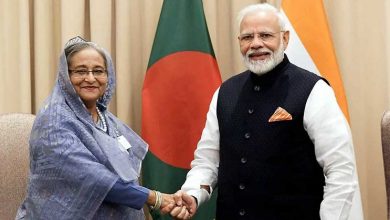Nelson Mandela International Day: 67 years spent in service of humanity

Nelson Mandela International Day (or Mandela Day) is an annual international day in honour of Nelson Mandela, celebrated each year on July 18, Mandela’s birthday.
The day was officially declared by the United Nations in November 2009, with the first UN Mandela Day held on July 18, 2010.
Absolute determination. A deep commitment to justice, human rights and fundamental freedoms. A profound belief in the equality and dignity of every woman and man. A relentless engagement for dialogue and solidarity across all lines and divisions.
Nelson Mandela was a great statesman, a fierce advocate for equality, the founding father of peace in South Africa.
In times of turbulence, Nelson Mandela shows us the power of resisting oppression, of justice over inequality, of dignity over humiliation, of forgiveness over hatred.
Let us recall the lessons of Nelson Mandela’s life, and the essential humanism that guided him: “For to be free is not merely to cast off one’s chains, but to live in a way that respects and enhances the freedom of others.”
History and significance
The UN General Assembly (UNGA) declared 18 July as “Nelson Mandela International Day,” in recognition of the contributions made by Nelson Mandela, the former South African President, to the culture of peace and freedom.
In the Resolution establishing this international day (A/RES/64/13), UNGA recognized Mandela’s values and his dedication to the service of humanity in: conflict resolution; race relations; promotion and protection of human rights; reconciliation; gender equality and the rights of children and other vulnerable groups; the fight against poverty; the promotion of social justice.
The resolution also acknowledged his contribution to the struggle for democracy internationally and the promotion of a culture of peace throughout the world.
In December 2015, the UNGA decided to extend the scope of Nelson Mandela International Day to also be used to promote humane conditions of imprisonment, raise awareness about prisoners being a continuous part of society, and to value the work of prison staff as a social service of particular importance.
It adopted (A/RES/70/175) the revised United Nations Standard Minimum Rules for the Treatment of Prisoners and approved that they should be known as the “Nelson Mandela Rules.”
“Do what you can, with what you have, where you are”
The theme for 2022 is “Do what you can, with what you have, where you are”
A global movement for positive change begins with small actions. As each person acts, they fuel momentum toward positive change, raising awareness and expanding the reach of Mandela’s values – fighting injustice, helping people in need and practicing reconciliation.
As United Nations Secretary General António Guterres put it:
“Our world today is marred by war; overwhelmed by emergencies; blighted by racism, discrimination, poverty, and inequalities; and threatened by climate disaster.
Let us find hope in Nelson Mandela’s example and inspiration in his vision. Today and every day, let us honour Nelson Mandela’s legacy by taking action. By speaking out against hate and standing up for human rights.
By embracing our common humanity – rich in diversity, equal in dignity, united in solidarity.
And by together making our world more just, compassionate, prosperous, and sustainable for all.”
The Story of Nelson Mandela
Nelson Mandela spent 27 years in prison for opposing South Africa’s apartheid system. He faced harsh conditions meant to break his resolve, but Mandela refused to give up his efforts to achieve equality for all people.
Despite the terrible personal cost of imprisonment, Mandela continued to act as a leader and mobilized his fellow political prisoners. After he was released, Mandela helped negotiate an end to apartheid and became the first democratically elected president of South Africa.
This is the story of Nelson Mandela’s journey from prisoner to president.

Mandela, in the 1950s. He worked as a lawyer, providing free or affordable representation to black people who defied apartheid laws.
Why did Mandela go to prison?
Mandela went to prison because he opposed South Africa’s apartheid laws.
Apartheid means “apartness” in the Afrikaans language. Apartheid laws separated South Africans into four different racial categories: “white/European,” “black,” “coloured (people of mixed race),” or “Indian/Asian.” White people – 15 percent of the South African population – stood at the top of society, wielding power and wealth. Black South Africans – 80 percent of the population – were relegated to the very bottom.
Many South Africans defied apartheid. Tactics included civil disobedience campaigns, national strikes and boycotts. Nelson Mandela joined this struggle in the 1940s as a young lawyer. By the 1950s, he had become an important leader in the struggle against apartheid.

Protestors in a train carriage marked “For Europeans Only” during the Defiance Campaign, 1952. In willful defiance, they hold their thumbs up as a sign of solidarity.
The South African government responded to demands for equality and freedom with repression and violence. They shot and killed unarmed demonstrators and detained and arrested many others.
Defiance of apartheid had started peacefully, but Mandela now believed that armed struggle was the only way forward. He and others formed an armed resistance group called Umkhonto weSizwe (“Spear of the Nation”), also known as MK. Mandela spent 17 months underground trying to gain support for the armed struggle, but was arrested in 1962. Then, in 1963, Mandela was put on trial for a number of charges. He and seven of his colleagues were sentenced to life in prison.

Mandela leaving the All‐In‐Africa Conference in Pietermaritzburg, 1961. He was a surprise speaker at the conference, where he called for a democratic South Africa.

Mandela meeting with Algerian freedom fighters, Morocco, 1962. While underground, he travelled extensively to meet other African leaders and groups fighting for liberation.
Robben Island Prison

Robben Island, South Africa, 1995. Prisoners were isolated from the outside world, but could see Cape Town, with its Table Mountain, mere kilometers in the distance.
Mandela and his compatriots were sent to a maximum security prison on Robben Island in 1964. There were no white prisoners on Robben Island. Mandela spent 18 of 27 years of imprisonment there, held with the other political prisoners who were kept in a separate section.

On Robben Island, prisoners faced harsh conditions meant to break their resolve. Rights were denied based on people’s skin colour. Black prisoners ate more poorly than Indian/Asian or coloured (people of mixed race) prisoners. Black men were forced to wear shorts and sandals, even in winter, while other prisoners could wear pants and shoes.
Mandela mending clothes at Robben Island, 1964. He is wearing shorts because black prisoners were not permitted to wear long pants. Mandela and his fellow political prisoners challenged this rule and it was eventually changed.
Political prisoners faced the worst conditions of all. Condemned to hard labour, Mandela and his fellow activists spent more than a decade breaking rocks in a lime quarry. Some prisoners were assaulted and tortured by guards.
Contact with the outside world was almost completely severed. When Mandela arrived on Robben Island, he was permitted one letter and one 30‐minute visit every six months. He was denied permission to attend the funeral of his mother, who passed away in 1968, and one of his sons, who died in a car accident in 1969. It would be 21 years before he could hold his wife, Winnie Mandela, again. His two young daughters, Zeni and Zindzi, had to wait until the age of 16 to see him.
Glass walls separated prisoners from visitors. They talked on phones as guards listened to every word. Letters were heavily censored, with words blacked out if they were not strictly personal. After prisoners found ways to read blackened content, censors began cutting out large portions of letters, reducing them to shreds.

Prisoners breaking stones at Robben Island, 1964. Inmates were forced to perform back‐breaking labour. They were not allowed to talk or sing while working.
Although these precious letters do not reach [you], I shall nevertheless keep on trying by writing whenever that is possible…. It is some means of passing on to you my warmest love and good wishes, and tends to calm down the shooting pains that hit me whenever I think of you.
Neslon Mandela from a letter written to his daughters Zeni and Zindzi Mandela
Despite their treatment, the prisoners on Robben Island continued to resist the apartheid regime in thousands of ways.
Mandela and other prisoners advocated for improved conditions and rights for all prisoners, regardless of race. In 1966, black prisoners secured the right to wear long pants instead of shorts. Eventually, prisoners were allowed to have a desk in their cells, and to read and study. They even planted a small garden.

Prisoners also achieved the right to play soccer, tennis and volleyball. Summer games were held at the prison, and prisoners took pride in organizing the events and creating intricate programs with limited materials. Music became another way for prisoners to express their shared humanity. They created a record club and organized concerts for events and holidays.A handmade certificate awarded by the Robben Island Amateur Athletic Association.
We regarded the struggle in prison as a microcosm of the struggle as a whole. We would fight inside as we had fought outside. The racism and repression were the same; I would simply have to fight on different terms.
Nelson Mandela
Outside the walls of Mandela’s prison, South Africans continued to resist the apartheid regime. In 1985, under increasing pressure, the government made an offer to release Mandela, on condition he renounce violence as a political tool. Mandela rejected the offer. His youngest daughter, Zindzi Mandela, read his response at a mass rally in Soweto:

“What freedom am I being offered while the organization of the people remains banned? What freedom am I being offered when I may be arrested on a pass offence? What freedom am I being offered to live my life as a family with my dear wife who remains in banishment in Brandfort? What freedom am I being offered when I must ask for permission to live in an urban area? What freedom am I being offered when I need a stamp in my pass to seek work? What freedom am I being offered when my very South African citizenship is not respected? […] Your freedom and mine cannot be separated. I will return.”
Mandela’s youngest daughter delivering her father’s response to an offer of conditional release at a rally, Soweto, 1985. Mandela rejected this offer with powerful words.
Mandela was committed to achieving freedom for all South Africans, not just for himself. In 1986, he began to quietly reach out to the South African government to see if there was interest in negotiating an end to apartheid.
Four years later, on February 11, 1990, the most famous political prisoner in the world was released. He was 71 years old, but there was still work to do. Years of fraught negotiations followed the end of Mandela’s imprisonment. Throughout this period, political violence and civil war threatened to engulf the country.
In 1993, South Africa adopted an interim constitution. This paved the way for the country’s first democratic elections. That same year, the Nobel Peace Prize was jointly awarded to Mandela and South African President F. W. de Klerk.
South Africa’s first democratic elections were held in 1994. When all the ballots were counted, Nelson Mandela had become the country’s first democratically elected president. Mandela would dedicate the remaining years of his life to transforming his country. He always acknowledged that there was still more to do – and that it was up to future generations to continue the struggle for freedom.
He died at his home in Johannesburg on 5 December 2013.





